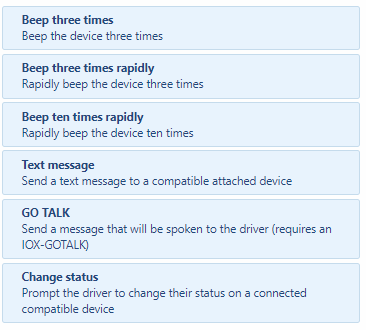Driving a plug-in hybrid with telematics: an engineer’s story
What is it like to drive a plug-in hybrid vehicle? Read the review and get tips from a Geotab senior embedded systems engineer.
By Geotab Team
Jul 24, 2018
Updated: Apr 24, 2023
4 minute read

I have been driving a Chevrolet Volt for about a year. First things first, the Volt is not an electric vehicle (EV), it is a plug-in hybrid electric vehicle (PHEV). This means it works as an EV while the battery is charged and as a hybrid once the battery is depleted.
The Volt is unique among currently available PHEVs in that it has a large EV range at 85 km (about 53 miles) and unlike most, when in EV mode it works just like an actual EV — whereas most other current PHEVs need help from the internal combustion engine (ICE) during instances of harsh acceleration or high speed. I drive my car almost exclusively as an EV because the 85 km range is more than adequate for my daily driving needs.
See Also: Hybrid Electric Vehicles Are More Efficient
It’s as Fun as They Say
The first thing I noticed when I started driving my PHEV was the incredible smoothness and quietness. Unlike ICEs, which operate with controlled explosions and move back and forth, electric motors are very quiet and move continuously in one direction. We are all used to the noise and vibrations from conventional vehicles so their absence becomes very noticeable when driving a PHEV in EV mode. The state of the road becomes more apparent in the absence of vehicle vibrations and you learn to appreciate driving on new asphalt.
The second thing I noticed was the continuous torque from the electric motor without the customary shifts. It feels as if the car has a very powerful engine. Electric motors generate their maximum torque all the way from stand still up to their maximum-rated speed. This translates into maximum acceleration at any speed within the range. As an engineer, I was aware of this but it was still quite an experience the first time I drove a PHEV.
It’s as Efficient as They Say
The most important thing I wanted to see was if the efficiency was as advertised. As I drove the vehicle day in and day out through spring and summer, it became evident that PHEVs and EVs do live up to their expected energy frugality.
In EV mode, my PHEV is rated at 2.2L-e/100km (106 MPG-e) and I consistently got 2.0L-e/100km (116 MPG-e). Now, these numbers may not mean much to most people, so I will put them in perspective and talk about something everybody is familiar with... money.
Using average 2017 U.S. energy prices ($2.42/gallon of gasoline and $0.12/kWh of electricity), a modern passenger car can be expected to travel about 18 km (11 miles) with $1 of gasoline. With $1 of electricity, my PHEV can travel 50 km (31 miles).
Creating a Better Telematics Experience for PHEVs
The first thing we wanted to do was to be able to determine the state of charge of the high voltage battery at any time. Our concern was to determine charge level while the vehicle was off and charging, without disturbing the vehicle. After some investigation, we figured out how to obtain this information from the vehicle. Now I am able to plot battery usage on MyGeotab and see discharging as
I am driving, and can see it charging when stopped and plugged in.
Another challenge was to determine when the vehicle was active. With no engine running (most of the time) we didn’t have all the information we normally expect from a vehicle, like RPM. But, we eventually figured that out how to look for vehicle activity in the vehicle’s communication bus.
Even though the engine almost never runs, we can determine when it is active and do not have to rely on GPS to know the car is active due to movement. This is particularly important when GPS signal is poor, especially in parking garages.
Tips for My Fellow EV/PHEV Drivers
Here are some tips for common issues you may encounter with your plug-in hybrid.
Silent Driving
Because the car is almost silent in EV mode, I have to take special care when driving around commercial parking lots. Pedestrians can have a sense (if paying attention) of active vehicles in their surroundings from engine noise, but silent cars creeping along on pure electric power do not provide any warning. It can be quite disconcerting seeing a car moving around that does not emit any sound.
Solution: I find the Geotab GO device reverse warning notification quite useful in reminding me to be extra careful.

Driver feedback options in MyGeotab
Winter Driving
Cold weather takes a toll on EV range. Batteries are less efficient in cold temperature and cabin heat is very energy intensive. Range can drop by as much as 40%. It is easy to forget that conventional vehicles are so inefficient that they waste energy in the form of heat, since this heat is useful to warm up the cabin in winter. But with EVs, there is so little waste from electric powertrains that there is no useful amount of heat to use for climate control.
Solution: Two things that come in handy are heated seats and a heated steering wheel. It is far less energy intensive to warm up just the seat and steering wheel than the entire cabin, and in many cases this is all that is needed to stay comfortable.
Braking
One of the advantages of electrified vehicles is their ability to recapture some energy during braking. Energy is required to accelerate a car and bring it up to speed. Less energy is needed to keep it going at constant speed. When a car is moving it has what is called kinetic energy (the initial energy put into it to bring it up to speed). To stop, this energy must be removed. In conventional vehicles, all this energy is “absorbed” by the brake pads and discs. The energy is transformed into heat. In EVs and all hybrids, the kinetic energy is used by the motor generator (M-G) to produce electricity that is used to recharge the battery (as long as braking is not too aggressive, as that would engage the conventional braking system).
Solution: Most electrified vehicles provide the driver with a visual cue that helps them to learn how to brake in such a way that only the generator is engaged. With the visual cue, I have found that I can drive using almost no conventional braking. It is even possible to touch the brake discs right after driving for a while, where in a conventional car that would result in burnt hands. Less brake use should also result in fewer brake changes throughout the life of the vehicle.
Staying Ahead
The cars we drive are increasingly expected to become electrified. As automotive technology changes, Geotab will continue to work to bring telematics to hybrid, plug-in hybrid and electric vehicles as it has been doing for several years with conventional vehicles.
Read about Geotab’s acquisition of clean-tech solution provider FleetCarma here.
Related
Subscribe to get industry tips and insights
Geotab Team
The Geotab Team write about company news.
Table of Contents
Subscribe to get industry tips and insights
Related posts

Marketplace Spotlight: From Chaos to Clarity, Innovating Fleet Claims with Xtract
April 15, 2025
1 minute read

What is government fleet management software and how is it used?
April 10, 2025
3 minute read

Beyond the road: Enhancing school bus interior safety with advanced technology
April 10, 2025
5 minute read

60+ trucking industry statistics: trends + outlook for 2025
April 8, 2025
6 minute read

Enhancing student bus safety: Combating distracted driving in the digital age
April 7, 2025
6 minute read
